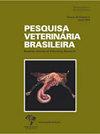Focal spinal hyperesthesia as a prognostic factor in paraplegic dogs without deep pain perception
IF 0.8
4区 农林科学
Q3 VETERINARY SCIENCES
引用次数: 0
Abstract
ABSTRACT: Intervertebral disc extrusion (IVDE) is the most common cause of spinal cord compression in dogs, whose prognosis is variable and depends on several factors, with deep pain perception (DPP) being the main parameter used. Investigations of new prognostic factors are studied to assist in the estimation of functional recovery. Thus, this study aimed to evaluate whether spinal hyperesthesia (SH) at the compression site can be used as a prognostic factor for the functional recovery of dogs with acute IVDE (Hansen type I), without DPP being subjected to thoracolumbar hemilaminectomy. Decompression surgery was performed on the same day or the day after admission. The duration of the loss of DPP until surgery performance ranged from 1 to 60 days, with a median of 4.5 days for the group of dogs with SH and 5.5 days for those without SH. Among the 68 dogs included in this retrospective study, 73.5% (50/68) showed SH, and 26.5% (18/68) were not identified. Recovery was satisfactory in 60% (30/50) of dogs with SH and in 27.7% (5/18) of dogs without SH, demonstrating that paraplegic dogs without DPP but with SH were 3.9 times more likely to recover when compared to dogs in the same condition, but with no SH. No studies have evaluated SH by palpation of the spine as a prognostic factor, which reinforces the relevance of the present study. The results of this study imply that SH in paraplegic dogs affected by thoracolumbar IVDE, without the presence of DPP, can be used as a possible prognostic indicator of functional recovery.局灶性脊髓感觉亢进是无深度痛觉的截瘫犬的预后因素
摘要:椎间盘突出(IVDE)是犬脊髓压迫最常见的原因,其预后变化很大,取决于多种因素,其中深度疼痛感知(DPP)是主要参数。研究了新的预后因素,以协助估计功能恢复。因此,本研究旨在评估在不进行胸腰椎半椎板切除术的情况下,压迫部位的脊髓感觉亢进(SH)是否可以作为急性IVDE (Hansen I型)犬功能恢复的预后因素。当日或入院次日行减压手术。DPP丧失的持续时间从1天到60天不等,有SH组的中位时间为4.5天,无SH组的中位时间为5.5天。在本回顾性研究的68只狗中,73.5%(50/68)出现SH, 26.5%(18/68)未被确定。60%(30/50)有SH的狗和27.7%(5/18)没有SH的狗的恢复令人满意,这表明没有DPP但有SH的截瘫狗的恢复可能性是没有SH的狗的3.9倍。没有研究通过触诊脊柱来评估SH作为预后因素,这加强了本研究的相关性。本研究结果提示,胸腰椎IVDE截瘫犬在不存在DPP的情况下,SH可作为功能恢复的可能预后指标。
本文章由计算机程序翻译,如有差异,请以英文原文为准。
求助全文
约1分钟内获得全文
求助全文
来源期刊

Pesquisa Veterinaria Brasileira
农林科学-兽医学
CiteScore
1.30
自引率
16.70%
发文量
41
审稿时长
9-18 weeks
期刊介绍:
Pesquisa Veterinária Brasileira - Brazilian Journal of Veterinary Research (http://www.pvb.com.br), edited by the Brazilian College of Animal Pathology in partnership with the Brazilian Agricultural Research Organization (Embrapa) and in collaboration with other veterinary scientific associations, publishes original papers on animal diseases and related subjects. Critical review articles should be written in support of original investigation. The editors assume that papers submitted are not being considered for publication in other journals and do not contain material which has already been published. Submitted papers are peer reviewed.
The abbreviated title of Pesquisa Veterinária Brasileira is Pesqui. Vet. Bras.
 求助内容:
求助内容: 应助结果提醒方式:
应助结果提醒方式:


